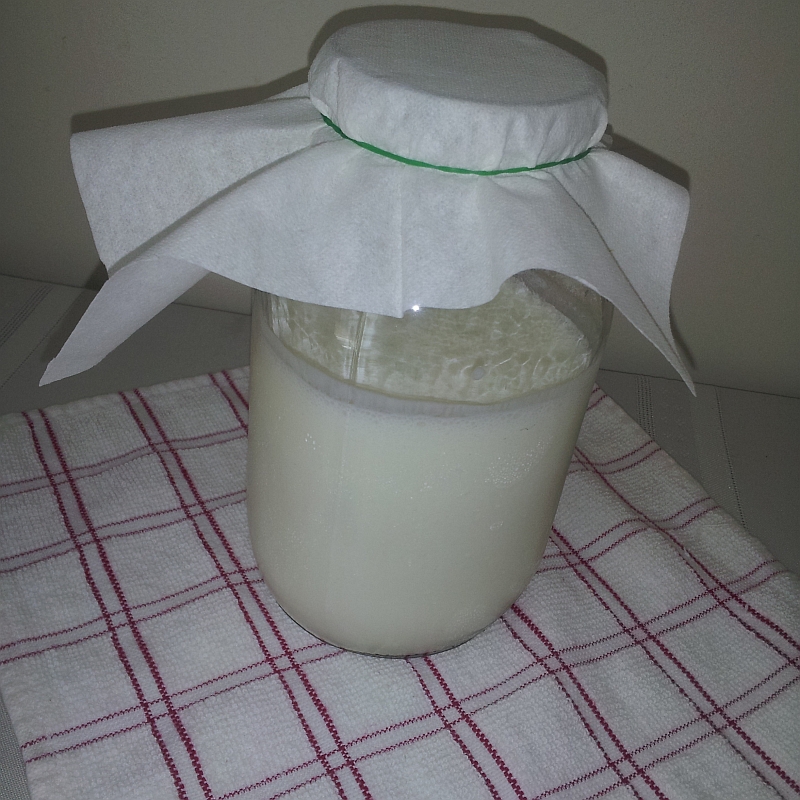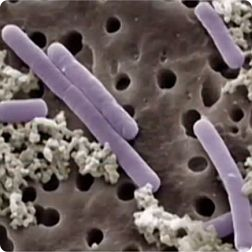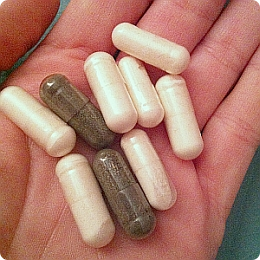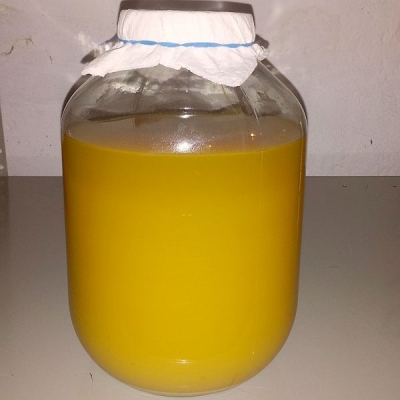Difference Between Prebiotics and Probiotics
Probiotics are microorganisms in a symbiotic relationship with humans, and prebiotics are the food for the microorganisms. In order to benefit from probiotics, (the good microbacterial flora), we need to nourish them, to allow the proper growth of their colony; without the proper food the micro flora would just starve and eventually die.

What Is the Difference between Probiotics and Prebiotics?
Probiotics are life forms, such as bacteria, or yeast, whereas prebiotics are just various substances to nourish the microflora.
Probiotics are beneficial bacteria and other microorganisms that live in symbiosis with humans. They help us to control pathogens and stay healthy. We, in turn, take care of them by feeding them properly and help them thrive.
Prebiotics are special fibers and other compounds, that stimulate the growth of probiotics.
This first explanation is a simplistic one, to give you a sense of the major differences between the two. Let’s dive a little deeper into the probiotic and prebiotic definition and look at how each of them can benefit our health, and what safety precautions we need to take.
Let’s make it clear, there is not a definitive consensus on the probiotic and prebiotic definitions, but “The International Scientific Association for Probiotics and Prebiotics (ISAPP)” released in 2013 a consensus statement on the definition and scope of prebiotics.
What Are Probiotics?
Probiotics are beneficial bacteria that live in our guts, and form a symbiotic relationship with us. We provide them a place to live, and food, they help us by killing or inhibiting the harmful bacteria, or other pathogens, strengthen our immunity, and help digestion and absorption of food.
In general, we don’t have to worry too much about feeding the probiotics, because they have enough food from our normal diet, as long as our diet is balanced.
The neat thing about them, is that they feed with dietary fiber that humans cannot digest, so for us is useless.
 Probiotics Examples
Probiotics Examples
The distinction between good and bad bacteria is attributed to Eli Metchnikoff, a Nobel Prize winner who observed that if we modify our flora to contain more of a certain bacteria, these harmless type of bacteria will replace the harmful ones.
At about the same time, Henry Tissier, a French pediatrician, discovered a direct correlation between the numbers of a certain bacteria, and the occurrence of diarrhea in children. Probiotics have started to get a lot more attention starting the nineties, and since then they have been proved beneficial in many health problems such as:
- diarrhea,
- inflammatory diseases, and bowel syndromes,
- constipation,
- cancer,
- allergies,
- cardiovascular disease,
- bacterial vaginosis,
- urogenital tract infections,
- yeast vaginitis, (Candida),
- LDL cholesterol control,
- anxiety and depression
- atopic dermatitis, and fungal dermatitis
- improve digestion and absorption
- synthesize vitamin K and B12
Probably the most important role is prevention, by keeping a healthy bacterial colony we prevent many health problems. Examples of probiotics: some Bifidobacterium strains, Lactobacillus acidophilus, Lactobacillus plantarum, Lactobacillus reuteri, Lactobacillus rhamnosus, Lactobacillus salivarius, Lactobacillus gasseri, Saccharomyces boulardii, (it is a yeast). Read more about the health benefits of probiotics here.
What Are Prebiotics?
Prebiotics were firstly defined by Gibson and Roberfroid in 1995. They said that prebiotics are non-digested food components that, stimulate the growth and/or activity of a single type or a limited amount of microorganisms in the human gastrointestinal tract, and as a result we get an improved health of the host.
Prebiotics are dietary fibers, in the form of carbohydrates, that humans cannot digest. Their sole purpose is to feed the bacteria in our guts.
When a probiotic and a probiotic are combined, they are called a synbiotic, and it is the form that is the most effective as treatment.
The most common example of synbiotic is yogurt, or kefir. It contains both the bacteria colony, and the food for it.
Prebiotic Types
There are more types of prebiotics: galacto oligosaccharides, fructans, (fructo oligosaccharides and inulins), (inulin is the most known prebiotic fructan), lactulose, (which is a synthetic sugar), and mannan oligosaccharides, (considered by some as not being a prebiotic).
The most known natural prebiotic sources for fructans are: garlic, onions, leeks, artichokes, asparagus, bananas, coffee substitutes, chicory root, honey, unpasteurized vinegar, whole grains, soybeans.
As we point out later in the article, prebiotics can be taken by themselves, or in combination with a probiotic. Prebiotic supplements are a viable source of prebiotic fiber, and the advantage is is that it can alter microbiota in a controlled way.
Most of the times just by taking a prebiotic supplement, we can give a boost to our gut flora. Let’s take a look at some of the prebiotics, and their health benefits, and possible connections with the probiotics.
Difference Between Prebiotics And Probiotics
Prebiotics vs Probiotics
If things are still confusing, here is another simpler explanation: Probiotics are the life forms that colonize our guts and skin, and keep us healthy. The larger and more varied is our microbiota, the better it is. Probiotics can be bacteria or yeast.
Prebiotics are substances that feed the probiotics. Prebiotics can be natural, or synthetic, and they are dietary fiber that we humans cannot digest.
Which One to Take – Probiotics or Prebiotics?
If you take both you have the best chances that the microbiota will thrive. If you only get probiotics, (the good bacteria), you get temporary health benefits. However, if your regular diet is low on prebiotics, (fiber), the colony will die of starvation.
For healthy individuals, increased doses of prebiotics will are the best approach. You are feeding your beneficial bacteria which will thrive and start to multiply.
On the other hand, for people with gastrointestinal disorders, such as irritable bowel syndrome, inflammatory bowel disease, or small intestinal bacterial overgrowth, prebiotics alone might worsen the symptoms. For these cases a combination of prebiotics and probiotics is better approach.
The reason is that pathogen microorganisms and opportunists feed on the extra fiber. When the balance between good bacteria and opportunists is correct, more fiber is perfect, but if the opportunistic microorganisms are grown out of control, you will feed these populations instead.
In many cases, prebiotics are not appropriate as a first step in restoring a healthy microbiota. People with food sensitivity will not be able to start on an increased fiber diet. For these cases, a high dose selective probiotic regimen is more appropriate.
The reality is that opportunistic microbes will eventually adapt and start feeding on prebiotics. So the best course of action is to first reduce the number of opportunist populations and eradicate pathogens in your digestive tract, and only after that you can start increasing your prebiotic fiber intake.
Sources of Probiotics and Prebiotics
The next logical question, when comparing prebiotics and probiotics is how we get them in our diet? Is one of them easier to get from dietary sources?
Prebiotic Sources
Yes, prebiotics are easier to get from a balanced diet. Be prepared to drastically change your dietary habits. The grain based foods, which are still touted as a great source of fiber, is one of the worst dietary choices. A simplistic way to approach this is to eat a variety of vegetables, legumes, and grains. Keyword is “a great variety” here. Each prebiotic will stimulate a specific strain of probiotic bacteria.
A more controlled way to modulate your microbiome are the prebiotic supplements. Prebiotic supplements are backed by research, and they target specific strains of bacteria. Targeting the stimulation of specific bacterial strains, known for their beneficial effects on human health, we have a great prediction of the health outcome.
There are supplements that fill a gap in your diet. There are prebiotics that are hard to get from natural sources. A simple example is Human Milk Oligosaccharides, HMO, which can be found in breast milk only.
For a healthy person, increasing the prebiotic intake might be just enough to keep them healthy, and boost immunity. However, a better and safer approach is to take both prebiotics and probiotics. This approach is more efficient even for healthy people, because it avoids unpleasant gastrointestinal side effects, such as gas, bloating, and stomach pain.
Probiotic Sources
The best probiotic source are the fermented foods. Fermented foods provide you with a variety of friendly bacteria and yeast that you cannot get from probiotic products. Eating a lot of fermented foods and fermented drinks is a brute force approach. You get a lot of microorganisms, which are know to bring beneficial effects. You are effectively targeting everything possible. The minor unpleasant side effects of the huge amounts of probiotics are offset by the huge health benefits.
The minor unpleasant side effects of the huge amounts of probiotics are offset by the huge health benefits.
The only problem with this approach is that you need a variety of fermented foods to tackle the digestive health from all possible angles. This is what people have done historically in the various cultures, and culinary traditions.
Some of these sources of probiotics are yogurt, kefir, sour pickles, etc…
A more targeted approach are the probiotic supplements. A probiotic supplement contains one or more probiotic strains that are backed by research, and which are known to produce a health benefit. The beauty of probiotic supplements is that you can focus on a specific issue, and it’s more convenient than making a variety of probiotic foods, and hoping for a positive outcome.
In real life, eating fermented foods is more of a prophylactic measure, whereas supplements are a treating measure.
The Best Approach Is To Take Both Prebiotics and Probiotics
Typically, all probiotics in foods, are well nourished. Lactobacillus probiotics in yogurt feed from milk, lactic acid bacteria in sauerkraut, or other brine pickles feed from the carbohydrates in the pickled vegetables.
When we move the fermented food in the fridge after the fermentation, we stop bacterial growth. Ideally, there should be some fiber left for the bacteria, but not too much. When you ferment a food for too long, you risk to starve the bacterial populations, and kill them.
If you take probiotics as a supplement, you might need extra prebiotic fibers, depending on your diet. Here is the abstract of a scientific research to show how effective are prebiotics if taken without probiotics: Prebiotic treatment of colitis with germinated barley
Conclusion
Prebiotics and probiotics are both beneficial for gut health. By eating a healthy balanced diet with a lot of vegetables and fermented foods, we ensure an optimal health for healthy individuals. However, for people with gastrointestinal disorders, the regimen is different.
Dr. Mike Discussing about Probiotics

Natural foods vs supplements and how should some take
Need some written info